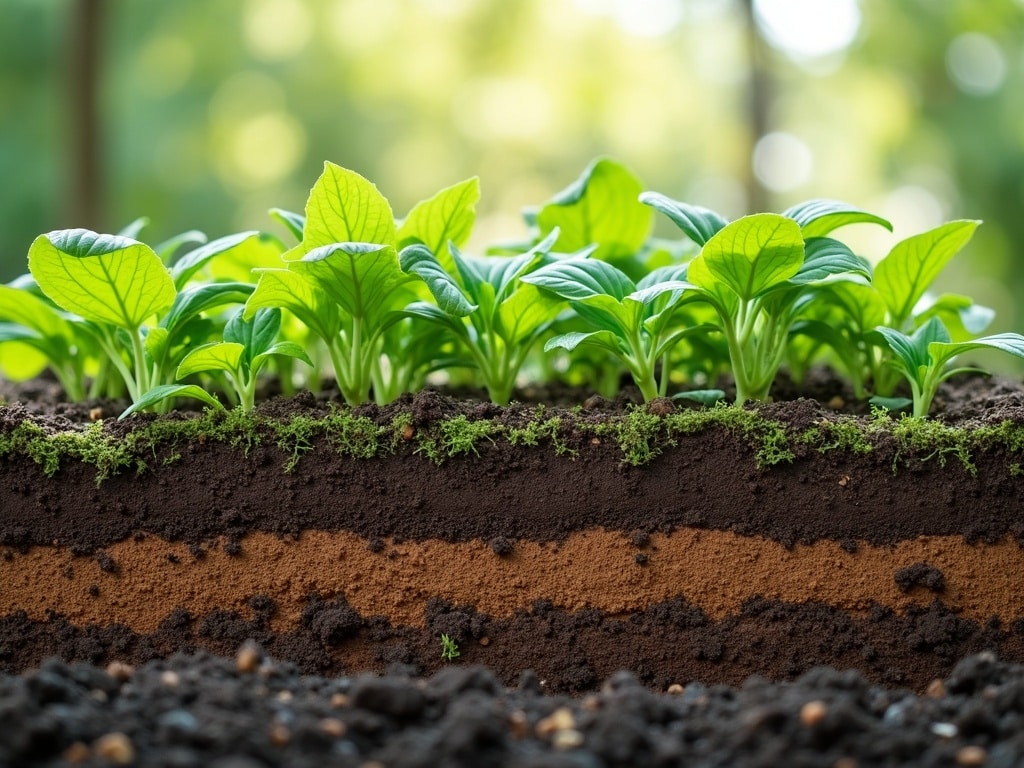Sheet Mulching to Build Soil: A Comprehensive Guide
Imagine transforming your tired, compacted soil into a thriving, fertile oasis without back-breaking tilling. That’s the promise of sheet mulching—a simple yet powerful technique that mimics nature’s own composting process, right in your garden. This method not only suppresses weeds and conserves moisture but, most importantly, builds rich, healthy soil teeming with life.
Understanding Sheet Mulching: Nature’s Way of Soil Building
Sheet mulching, also known as lasagna gardening, is a no-dig gardening technique that involves layering organic materials on top of the soil to create a rich, fertile growing medium. Think of it as a compost pile built directly on your garden bed. This process avoids the disruption of tilling, which can harm beneficial soil organisms and lead to erosion. Instead, sheet mulching encourages a thriving ecosystem of microbes, fungi, and earthworms to do the work for you, breaking down the organic matter and enriching the soil from the top down. This in turn creates healthier soil as the organic components will improve the structure, drainage, and overall fertility of the earth.
The Benefits of Sheet Mulching: Why Choose This Method?
Sheet mulching offers a multitude of advantages for the gardener seeking a sustainable and effective way to improve soil health:
- Improves Soil Structure: Adds organic matter, creating better drainage in clay soils and improving water retention in sandy soils.
- Suppresses Weeds: Blocks sunlight, preventing weed seeds from germinating and eventually smothering existing weeds.
- Conserves Moisture: Reduces evaporation from the soil surface, lessening the need for watering.
- Enhances Soil Fertility: Provides a slow-release source of nutrients as the organic materials decompose.
- Attracts Beneficial Organisms: Creates a welcoming habitat for earthworms, microbes, and other beneficial soil life.
- Reduces Erosion: Protects the soil surface from wind and water erosion.
- No Digging Required: Eliminates the need for tilling, which can damage soil structure and bring weed seeds to the surface.
Materials You’ll Need for Sheet Mulching
Gathering the right materials is key to successful sheet mulching. The basic components are a carbon-rich layer (browns), a nitrogen-rich layer (greens), and a top layer of mulch. Here’s a breakdown:
- Carbon-Rich Materials (Browns): These provide the bulk of the mulch and decompose slowly, providing a long-term source of carbon. Examples include:
- Cardboard (corrugated, with tape and labels removed)
- Newspaper (black and white only, avoid glossy inserts)
- Dry leaves
- Straw
- Shredded paper
- Wood chips
- Nitrogen-Rich Materials (Greens): These decompose quickly, providing a boost of nitrogen to fuel the composting process. Examples include:
- Grass clippings
- Vegetable scraps
- Coffee grounds
- Manure (well-rotted)
- Compost
- Seaweed
- Mulch: The final layer of material serves to protect the lower layers and keep them moist. Examples include:
- Wood Chips
- Straw
- Shredded Bark
- Optional Amendments: These can be added to further enhance the soil and provide specific nutrients:
- Rock dust
- Kelp meal
- Bone meal
- Composted manure
- Water: Essential for moistening each layer and promoting decomposition.
Step-by-Step Guide to Sheet Mulching
Now, let’s get down to the practical steps of creating your sheet mulch garden bed:
- Prepare the Area: Mow down any existing grass or weeds as close to the ground as possible. Remove any large, woody weeds that may be difficult to smother.
- Water the Area: Thoroughly water the area to be sheet mulched. This will help to initiate the decomposition process and provide moisture for the soil organisms.
- Lay Down the Cardboard or Newspaper Layer: This is your weed barrier. Overlap the edges of the cardboard or newspaper by at least 6 inches to prevent weeds from pushing through. Wet the cardboard or newspaper thoroughly to help it stay in place and begin breaking down.
- Add a Layer of Nitrogen-Rich Materials (Greens): Spread a 2-4 inch layer of nitrogen-rich materials over the cardboard or newspaper. This could include grass clippings, vegetable scraps, coffee grounds, or well-rotted manure.
- Add a Layer of Carbon-Rich Materials (Browns): Spread a 4-8 inch layer of carbon-rich materials over the nitrogen-rich layer. This could include dry leaves, straw, or shredded paper.
- Add Optional Amendments: If desired, sprinkle rock dust, kelp meal, or other amendments over the carbon-rich layer.
- Water the Layers: Thoroughly water all the layers to ensure they are moist.
- Add the Final Mulch Layer: Spread a 2-4 inch layer of mulch over the entire bed. This will help to retain moisture, suppress weeds, and improve the appearance of the bed.
- Wait: Allow the sheet mulch to decompose for at least 4-6 weeks before planting. The longer you wait, the more decomposed the materials will be, and the richer the soil will become.

Tips for Successful Sheet Mulching
To ensure your sheet mulching efforts are a success, consider these helpful tips:
- Choose the Right Location: Select an area that receives adequate sunlight for the plants you intend to grow.
- Remove Tape and Labels from Cardboard: These materials do not decompose and can contaminate the soil.
- Avoid Glossy Paper: Glossy paper contains inks and coatings that can be harmful to the soil.
- Use a Variety of Materials: A mix of different carbon-rich and nitrogen-rich materials will provide a wider range of nutrients and support a more diverse soil ecosystem.
- Water Regularly: Keep the sheet mulch moist, especially during dry periods.
- Be Patient: Decomposition takes time. The longer you wait before planting, the better the results will be.
- Consider your climate: Adjust the materials used based on your climate and available space.
Troubleshooting Common Sheet Mulching Problems
Even with careful planning, you might encounter some challenges. Here’s how to address them:
- Weeds Growing Through: If weeds are pushing through the cardboard or newspaper, add another layer of these materials, ensuring good overlap.
- Slow Decomposition: If the materials are not breaking down quickly enough, ensure they are adequately moist and consider adding more nitrogen-rich materials. You can also aerate the pile by gently turning it with a pitchfork.
- Pests: If pests are attracted to the sheet mulch, avoid using meat scraps or dairy products in the nitrogen-rich layer. Ensure that composted manure is completely broken down before using.
- Slugs and Snails: These pests can sometimes be attracted to moist environments. Consider using diatomaceous earth or other organic pest control methods to manage them.
Planting in Your Sheet Mulch Garden
Once the sheet mulch has decomposed for several weeks, it’s time to plant. Here’s how:
- Create Planting Holes: Push aside the mulch and cut a hole in the cardboard or newspaper layer large enough to accommodate the root ball of your plant.
- Add Compost or Potting Soil: Fill the hole with compost or potting soil to provide a rich growing medium for the plant’s roots.
- Plant Your Seedlings or Seeds: Plant your seedlings or seeds as you normally would, ensuring that the roots are in contact with the compost or potting soil.
- Water Well: Water the newly planted seedlings or seeds thoroughly.
- Mulch Around the Plants: Replace the mulch around the plants to help retain moisture and suppress weeds.
Long-Term Maintenance of Your Sheet Mulch Garden
Sheet mulching is not a one-time fix. To maintain a healthy and productive garden, you’ll need to replenish the mulch and add organic matter regularly.
- Add Mulch Annually: Add a fresh layer of mulch each year to replenish the materials that have decomposed.
- Incorporate Compost: Incorporate compost into the planting holes or as a top dressing to provide a continuous source of nutrients.
- Practice Crop Rotation: Rotate your crops each year to prevent nutrient depletion and reduce the risk of pests and diseases.
Sheet Mulching: A Sustainable Path to Soil Health
Sheet mulching is more than just a gardening technique; it’s a philosophy of working with nature to create a thriving ecosystem in your backyard. By embracing this method, you can transform your soil, reduce waste, and create a beautiful and productive garden for years to come. So, gather your materials, get layering, and witness the magic of sheet mulching unfold before your eyes. Your garden – and the planet – will thank you for it.
